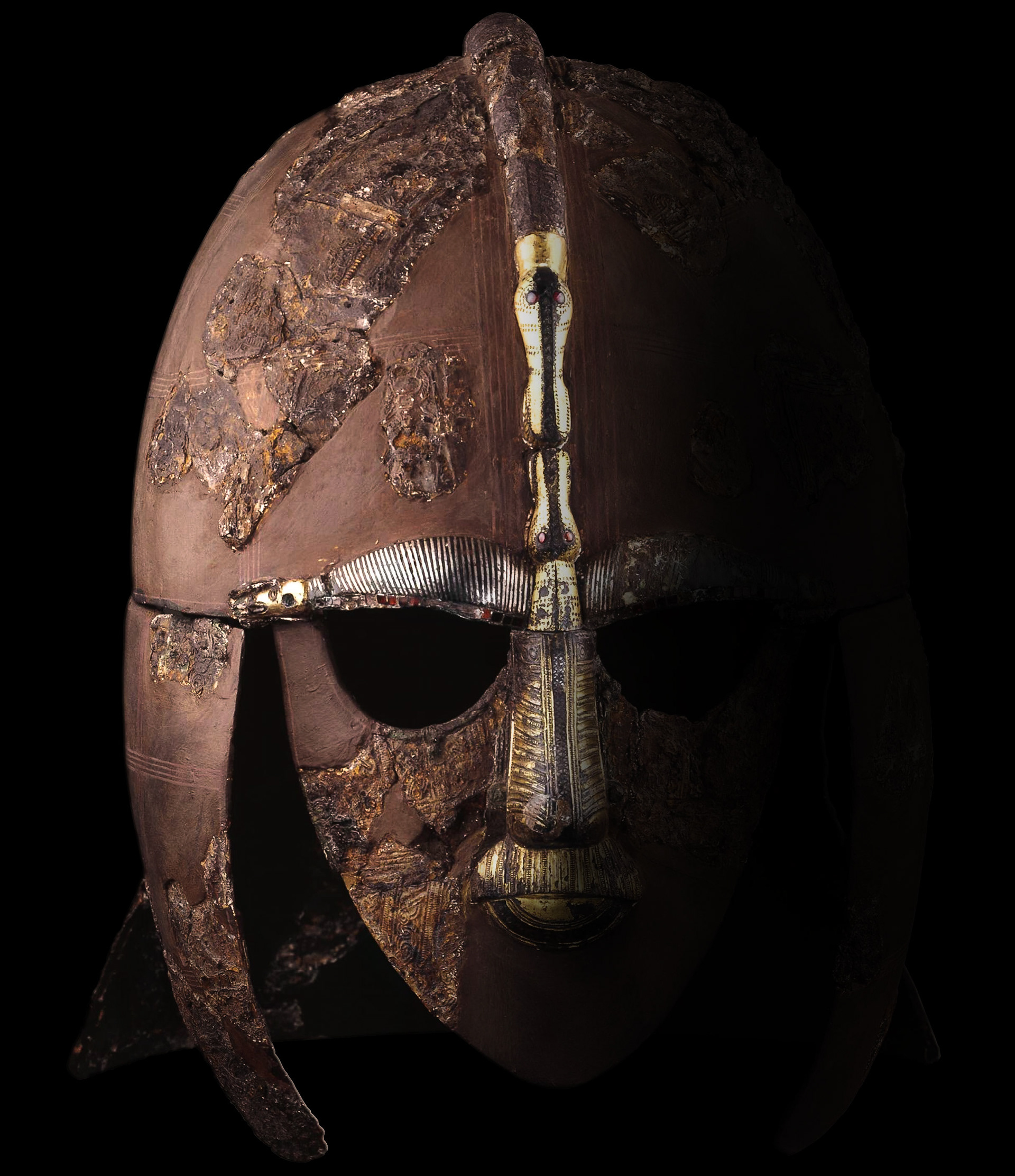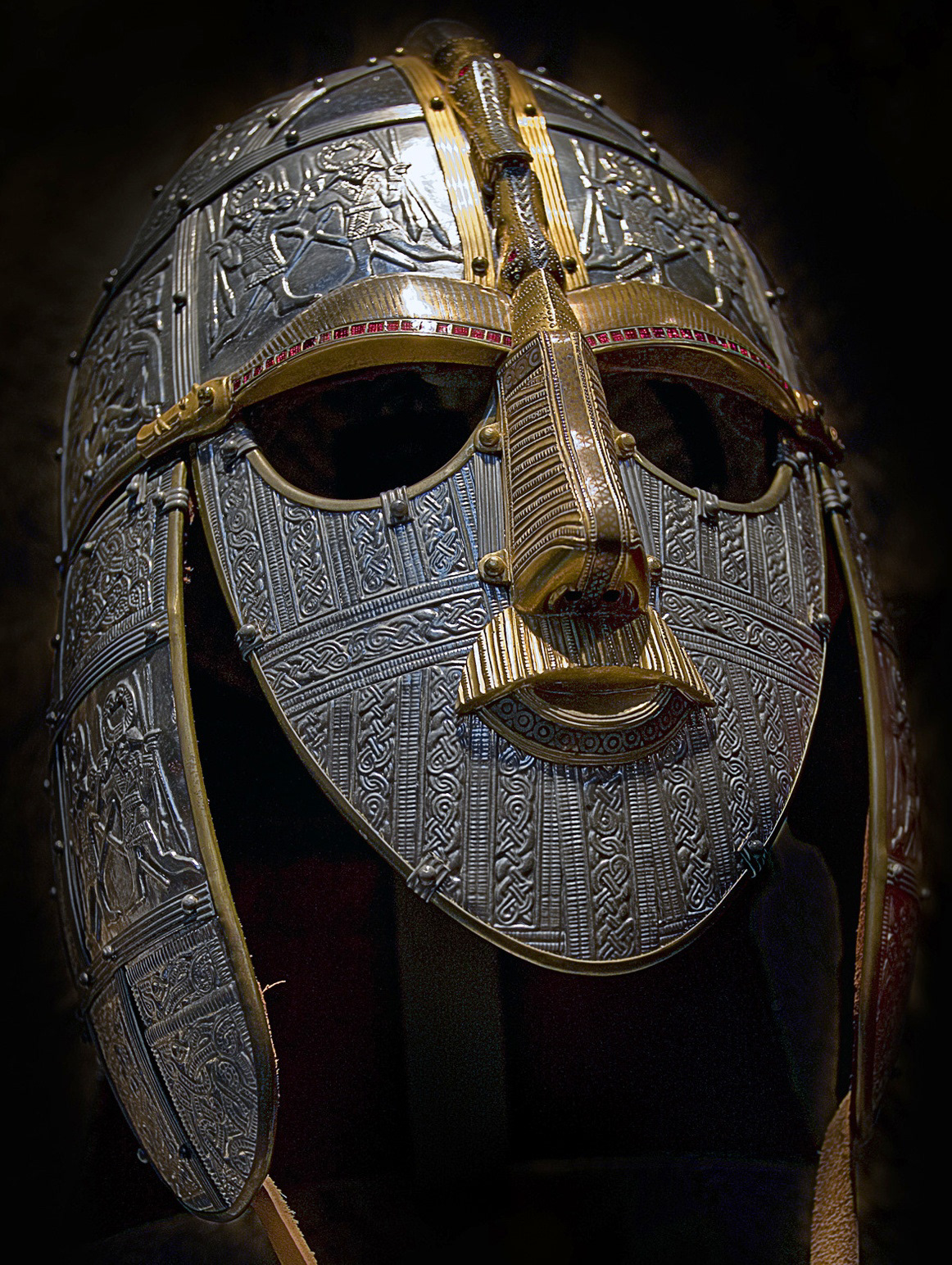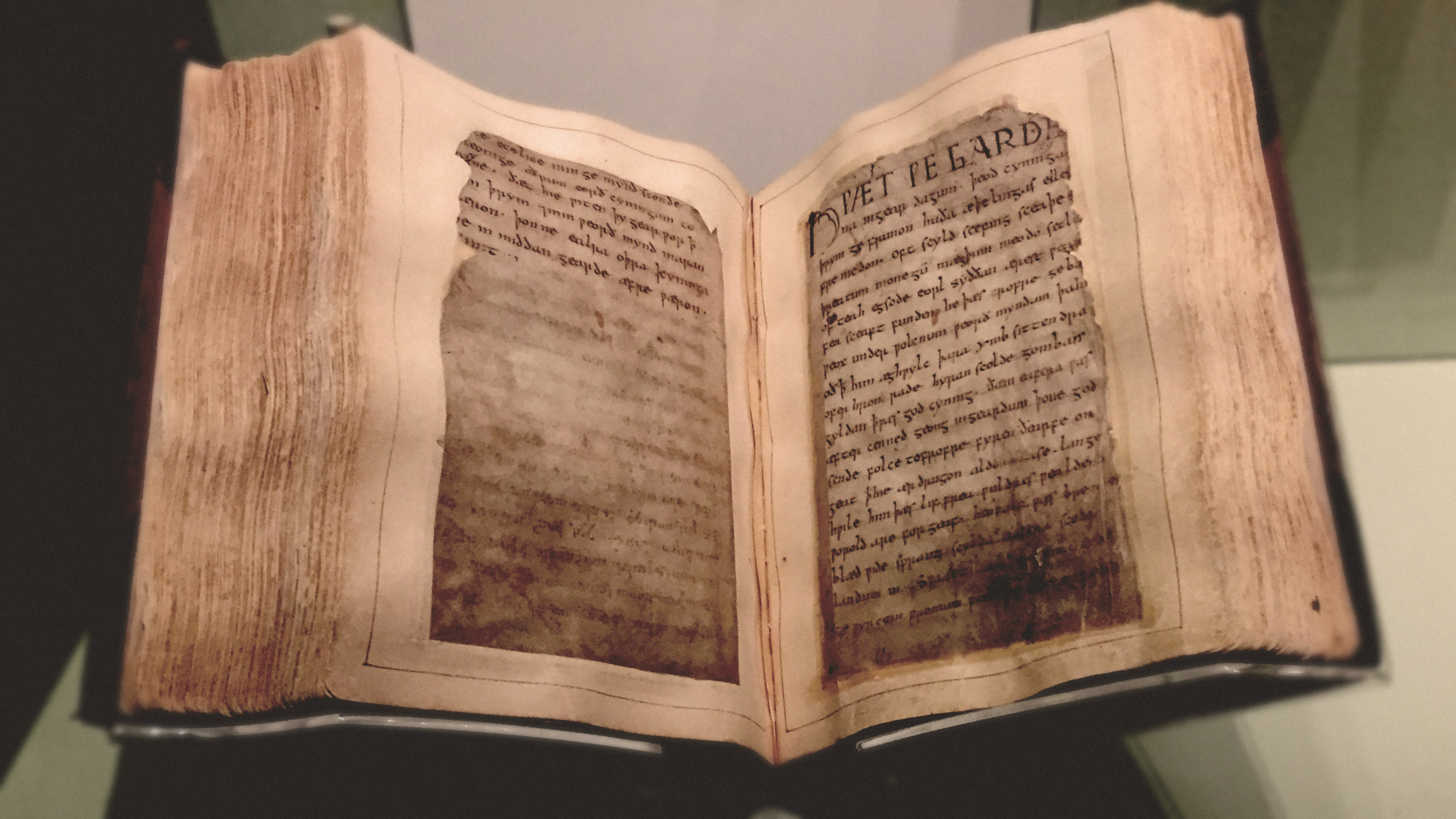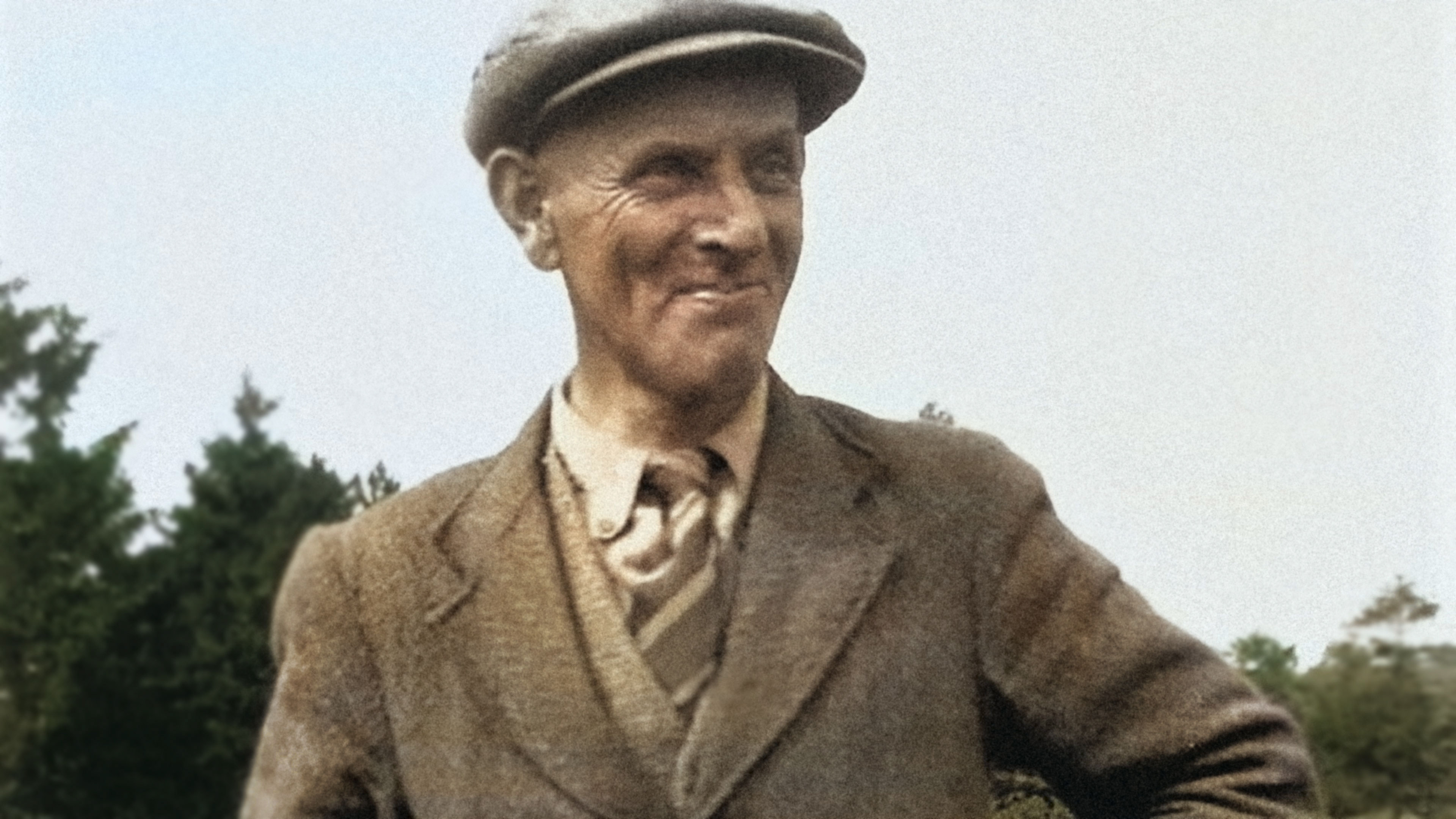In England 1939, an elaborate Anglo Saxon helmet was found in a lavish burial chamber filled with gold, jewellery and personal effects, that had been untouched for 1400 years. The helmet immediately captured world attention and gave archeologists new access to a culture that had remained shrouded in mystery until the twentieth century. Because there are no reliable written records from the early days of the Anglo-Saxons, historians rely on archeological remains to gain knowledge of this darkest of dark ages. Thousands of burial sites have been discovered across Britain, but nothing like this particular burial had ever been found before. The find was so revelatory that the helmet has become a symbol for archeology itself.
The Anglo Saxons rose to power in Britain after the Roman Empire lost control of the island in the 5th century AD. The Anglo Saxons, and really England itself, was born out of the ruins of Roman Britain. But one might argue that the Anglo Saxon mythos began even earlier in western history. In the early days of the Roman empire, Britain was seen as the land of mystery, the edge of the known world, inhabited by wild, long haired barbarians. Julius Caesar was the first Roman emperor to invade Britain in 55 and 54 BC. He came to Britain, he saw Britain, but he failed to conquer it on both attempts. It would take another one hundred years for the emperor Claudius to successfully conquer Britain in 43 AD, establishing the northern reach of the Roman Empire. In the following centuries, Roman Britain became a valuable part of the Roman Empire. But control of Britain was hotly contested by native Britons and invading Germanic hordes and required a staggering amount of soldiers to keep the peace and secure the borders.
By 410 AD, the Western Roman Empire was collapsing and the tens of thousands of Roman troops that had once held the province of Britania had been pulled out. This power vacuum was filled by both native Britons and sea-faring Germanic invaders, including Jutes, Angles and Saxons. This mix of indigenous British and Germanic immigrants would form both the language and cultural group known as “Anglo-Saxon.” The nearly four hundred years of Roman rule had come to an end.
The Anglo-Saxons established the Kingdom of England during a period sometimes referred to as the lost centuries, from about 400 to 600 AD. During this time, Britain was a cultural and religious melting pot. Chritianity mixed with paganism. The vestiges of Roman civilization gave way to British and Anglo Saxon kingdoms. This was the very beginning of English history. These so-called lost centuries represent one of the darkest periods for scholars studying medieval Britain. The Anglo-Saxon language, also known as Old English, was not written down until the 7th century. The epic poem Beowulf, the most famous Anglo Saxon work, was not penned until the 10th century, although it takes place in the sixth century. Even by the twentieth century, little was known of this time and place. However, this would change when a wealthy widow named Edith Pretty became curious about a mysterious set of mounds on her estate called “Sutton Hoo,” off the Suffolk Coast.
By 1937, the 53 year-old Pretty had spent decades wondering what mysteries lay beneath these earthen mounds. She could see the mounds clearly from her house, which sat on a bluff looking down to the river Deben. The mounds were actually marked on maps as Roman tumuli, Roman burial mounds. There was even a story about a guest who saw an apparition of an armed warrior galloping through the estate. Pretty decided to hire a local, self-taught archaeologist named Basil Brown to investigate.
In May of 1939, on the eve of World War II, Brown unearthed one of the greatest treasure troves in British history. The remains of an 88-foot ship were discovered beneath the largest of the Sutton Hoo mounds. The ship had been hauled up from the river and contained a burial chamber filled with gold coins, gold jewelry, silver cutlery and a double edged sword and shield. But by far the most iconic artifact found in the grave was an iron helmet, wrapped in a cloth. At some point in time, the burial chamber collapsed and crushed the fragile helmet into hundreds of unrecognizable fragments, causing the discovery to initially go unnoticed. It would take twenty-five years to correctly put the helmet back together. Although much of the iron had rusted away, there was enough of the original helmet to fill in the missing areas.
After reconstruction, the helmet proved to be a work of intricate artistry that told tales of far away lands and pagan gods. This was an amazing moment for Brown and Pretty. A literal face from the darkest medieval age rose up out of the earth. But whose helmet was it? The burial site was so lavish that it could have only belonged to royalty. But was it a grave or simply a monument to a fallen king? The acidic soils were thought to have long ate away any human remains. Brown never found any bones, but he did find a conspicuous, human shaped gap in the buried treasure. Later scientific analysis confirmed trace human remains in the soil, reinforcing the initial belief that this was in fact a gravesite.
Now, given that the Sutton Hoo estate lies on land that was once part of the kingdom of East Anglia, and given the date of coins and other items found in the grave, archeologists believe the tomb likely belonged to a powerful East Anglian King named Rædwald. And although we don’t know much about this warrior King, we do know that he reigned from 599 to 624, and that he was one of the first East Angles to convert to Christianity.
Christianity had spread through the Roman Empire after the emperor Constantine the Great issued the edict of Milan in 313, allowing Christians to freely practice their faith, and consequently, allowing the religion’s rapid spread. But eastern Britain was largely pagan until Pope Gregory the Great sent an Italian Monk named Augustine on a mission to convert the barbarians of Britain. Augustine arrived in south-east England in 597 and convinced Æthelberht, King of Kent to become a Christian. Augustine established a cathedral at Canterbury, and became the first Archbishop of Canterbury. Incidentally, Augustine brought an illuminated gospel book with him to England that survives to this day at the University of Cambridge. It’s called “The Gospel of Saint Augustine.”
Now Æthelberht’s conversion was important because he actually ruled over other Anglo-Saxon Kingdoms, including Rædwald’s. Æthelberht maintained something called overlordship, a kind of feudal authority over other kings, and it seems Rædwald converted to Christianity while in Kent, ostensibly under the influence of Æthelberht.
Historians believe Rædwald’s conversion was not accepted by his family and that Rædwald, in an act of appeasement, ended up keeping a temple with two altars, one to pagan gods, and one to Christ. We see these dueling faiths reflected in the contents of the Sutton Hoo burial that contain both Pagan and Christian items, although the act of ship burial itself is a clear pagan tradition. The 7th century was a time of great cultural flux. Christianity would soon sweep across all of Europe. This was the beginning of a new era. Chrisitan monks would soon start recording British history in Latin. Anglo Saxon kings would be buried with Christian rites, replacing the pagan practice of being buried with one’s treasures. And so this is what makes the discovery at Sutton Hoo so incredible. The amatuer archaeologist Basil Brown found a time capsule buried at the end of these lost British centuries. Now the gold and jewels and large ship were all immensely important artifacts in their own right, but nothing resonated more than the iron helmet.
The helmet is primarily made of iron, but also uses tin, bronze, gold, silver and inlaid garnets. The eyebrows, nose, and mustache form a dragon made of gilt copper. The wings of the dragon that form the eyebrows are inlaid with silver wire and end in boar heads. Garnets are used to give the dragon fiery red eyes and also line the dragon’s wings. Two cheek guards are attached with leather ties. A neck guard extends from the back of the cap and the face mask is riveted above the nose. These elements are similar in design to Roman cavalry parade helmets. It’s likely that kings like Rædwald carried themselves as natural heirs to their Roman predecessors. The Romans created the most powerful empire the world had ever known. There would have been a clear advantage in tying oneself to such a legacy.
Most of the helmet was originally covered with copper alloy sheets that were stamped with heroic warrior motifs and interlaced animal patterns. These decorations are better seen in the reconstructed version of the helmet. This leather lined replica, made by the British Royal Armories, can be worn and subjected to experimentation in ways the original could not. The reconstructed warrior scenes are based on fragments found at the burial site.
The helmet also has a peculiar asymmetry in the garnet cloisonné of eyebrows. Archeologists have discovered that nearly all Anglo Saxon jewel smiths used thin foils of gold behind inlaid garnets to produce a bright reflective glow. All the garnet jewelry found at Sutton Hoo uses this foil backing except for the twenty-five garnets on the helmet’s left eye, causing the garnets in the right eye to appear brighter. A working theory argues the missing foil in the left eye was intentional. When the helmet was worn in sunlight, the right eyebrow would shine more brightly, possibly evoking the warrior god Odin who traded one of his eyes for wisdom. This theory further suggests that the illusion would be exaggerated in gloomy interiors, when the garnets were lit only by firelight.
This theory is reinforced by another famous ship burial in Valsgärde, Sweden that also contained a helmet with garnets missing reflective backing only in the left eyebrow. The Valsgärde helmet is also decorated with the same stamped warrior motifs found on the Sutton Hoo helmet. These types of helmets were clear emblems of wealth and power and could have doubled as battle crowns. We might even imagine the owner of the Sutton Hoo helmet claiming to descend directly from Odin, as many Anglo-Saxon kings did.
The discovery at Sutton Hoo changed the way we understand Anglo-Saxon culture. The vast contents in the burial mound allowed archaeologists to connect 7th century material culture with practices previously only known through myth and legend. And the most famous of all Anglo Saxon legends is that of Beowulf. The story takes place in Sweden and Denmark in the 6th century and describes lavish ship burials, just like at Sutton Hoo. The Beowulf poem describes warriors with helmets crested with boar heads, matching specifically with the Sutton Hoo helmet. The eponymous hero Beowulf wears a glittering helmet fitted with boar figures, believing that he would be protected by the animal’s spirit, and that “no sword could bite.”
Archeologists could now use the context of the boar-crested helmets within the narrative of Beowulf to interpret the burial items found at Sutton Hoo. For instance, boars in Beowulf were the fiercest creatures in the forest. They were wild beasts capable of killing men who stood in thier way. Boars have proved to be a ubiquitous pagan symbol in Anglo Saxon culture. The impact on scholarship was huge. Beowulf contains 3,000 lines that accurately describe this lost culture. J.R.R. Tolkien, by far the most famous Anglo Saxon scholar, argued that Beowulf is most useful as a historical document that powerfully describes the spirit of the Anglo Saxon age.
We can now easily imagine the owner of the Sutton Hoo helmet entering the great halls described in Beowulf, with his silvery armour reflecting firelight, speckled with highlights of gold and garnet, flashing the eye of Odin. The trove of artifacts found at Sutton Hoo caused historians to rethink many conceptions of Britain’s so-called dark ages. The burial items demonstrated a previously unknown level of craftsmanship and sophistication. The items revealed a complex society with connections extending far beyond the island of Britain, providing a window into the culture that laid the foundations of English society. The striking visage of the Sutton Hoo helmet has the ability to capture the imagination in a way only tangible objects can, with a visceral power, allowing us to emotionally connect with these lost centuries.
Epilogue:
The last mound at Sutton Hoo was dug up in the Summer of 1939. In August of 1939, Edith Pretty was awarded ownership over the Sutton Hoo treasure and she promptly donated everything to the British Museum. The richness of the Sutton Hoo discovery had already made headlines around the world but war was just around the corner and the British Museum had already begun preparing to store its most valuable possessions in safe locations throughout England. World War II officially began on September 1st when Germany Invaded Poland and England declared war with Germany. To protect the Sutton Hoo treasure from German aerial bombing, the treasure was stored in the London Underground at Aldwych station. And so after spending fourteen centuries buried in the earth, the Sutton Hoo treasure would spend the remainder of the war locked in a crate, ninety-feet underground.

Sutton Hoo Helmet


Reconstructed Burial Mound

Burial Chamber Illustration

Reconstructed Helmet


Roman Parade Helmet


Beowulf Manuscript

Edith Pretty

Basil Brown

J.R.R. Tolkien
watch the video version of this article
